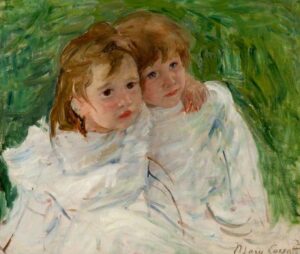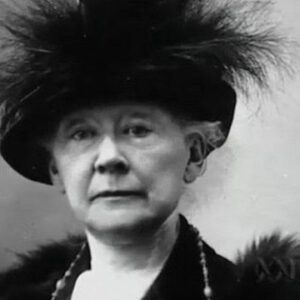Mary Cassatt was an American painter known for capturing the close link between mothers and children in her paintings. She was a key figure in the Impressionist movement, and she is regarded as one of the best female artists of her day, alongside Marie Bracquemond and Berthe Morisot. Her paintings show that she was particularly interested in investigating the private and social life of women as an artist. She was born into an upper middle-class household and obtained a decent education while growing up in a culturally stimulating atmosphere. Mary Cassatt was very close to her mother, a well-educated and sophisticated lady who had a huge influence on her. Cassatt was a world traveler who was inspired to pursue art as a vocation after seeing the works of artists such as Ingres, Delacroix, Corot, and Courbet during a trip to France. She began her painting studies at the Pennsylvania Academy of the Fine Arts before moving to Paris to further her education. Though she struggled to make a name for herself as an artist at first, she gradually gained popularity with her paintings depicting women and children from her own perspective. She never married and spent her entire life pursuing her genuine passion, art.
Childhood and Adolescence
Mary Stevenson Cassatt was born into a rich family on May 22, 1844, in Allegheny City, Pennsylvania, United States. She was the youngest of six siblings.
Her father, Robert Simpson Cassatt, was a successful stockbroker and land speculator, and her mother, Katherine Kelso Johnston, was a well-educated, intellectual, and energetic woman who influenced Mary greatly.
Her parents made sure she got a decent education and was taught talents like homemaking, embroidery, music, sketching, and painting, which were considered vital for women in her period.
In the 1850s, her family migrated to Europe and resided there for several years. During this period, she went to the 1855 Paris World’s Fair and met Degas and Pissarro, who would eventually become her teachers.
She discovered her love for painting and chose to pursue a career as an artist. Her parents objected to her choice of profession, but she enrolled in the Pennsylvania Academy of the Fine Arts in Philadelphia to study painting.
She attended the academy from 1861 to 1865, but she was dissatisfied with the way the institution treated its female
pupils. In 1866, she finished her studies and proceeded to Paris to study privately.
Jean-Léon Gérôme, a well-known teacher, accepted her as a pupil, and after a period of study with him, she enrolled in a painting class taught by Charles Chaplin, a well-known genre artist.
In 1870, when the Franco-Prussian War erupted, she was compelled to return home to live with her parents. Her father continued to oppose her dreams, and she battled to establish herself as an artist.
The Career of Mary
In 1871, Mary Cassatt returned to Europe. In the Salon of 1872, her painting ‘Two Women Throwing Flowers During Carnival’ was highly received and sold. Her reputation as a promising artist grew quickly.
She chose to settle in France in 1874 and founded a studio in Paris. Her sister Lydia soon followed, and by 1877, her parents had also moved into her apartment.
In 1877, she was invited to join the Impressionists by artist Edgar Degas, who had started their own series of independent exhibitions in 1874. She adored Degas’s art and joined the Impressionists right away, becoming the group’s lone American member.
She developed her approach and altered her technique and composition after being influenced by Degas and others. Degas became her primary tutor, offering advice on technique and encouraging her to try new things.
Family themes and portraits of women drew Mary Cassatt’s attention, and she was particularly fascinated by the bond between mothers and children.
‘Mother and Child Before a Pool,’ ‘The Child’s Bath,’ ‘Under the Horse Chestnut Tree,’ and ‘Madame Meerson and Her Daughter’ are just a few of her well-known paintings that illustrate the close bond between mothers and children.
She became an advisor to numerous prominent art collectors after earning popularity and success as a painter.
Her Major Projects
‘The Child’s Bath,’ (1893), is one of her most well-known paintings, representing touching moments between a mother and her child. The scene is based on a typical child’s bathing routine, and it depicts how the mother tenderly bathes her child.
Achievements & Awards
In 1904, Mary Cassatt was awarded the Légion d’honneur for her services to the arts.
Personal History and Legacy
She was completely dedicated to her craft and knew at a young age that marriage would be damaging to her profession, so she never married. She was also an outspoken feminist who refused to be labeled a “woman artist.”
She had a close association with Edgar Degas, an artist who was also her mentor. He had a big influence on her, and he gave her advice on how to paint.
Throughout her later years, she battled a variety of medical issues. She was diagnosed with diabetes, rheumatism, neuralgia, and cataracts in 1911, and at the end of her life, she was completely blind.
Mary Cassatt died at Château de Beaufresne, near Paris, on June 14, 1926.

Photo Credit: Art UK
Estimated Net worth
Mary is one of the wealthiest painters, as well as one of the most popular. Mary Cassatt’s net worth is estimated to be $1.5 million, according to Wikipedia, Forbes, and Business Insider.


